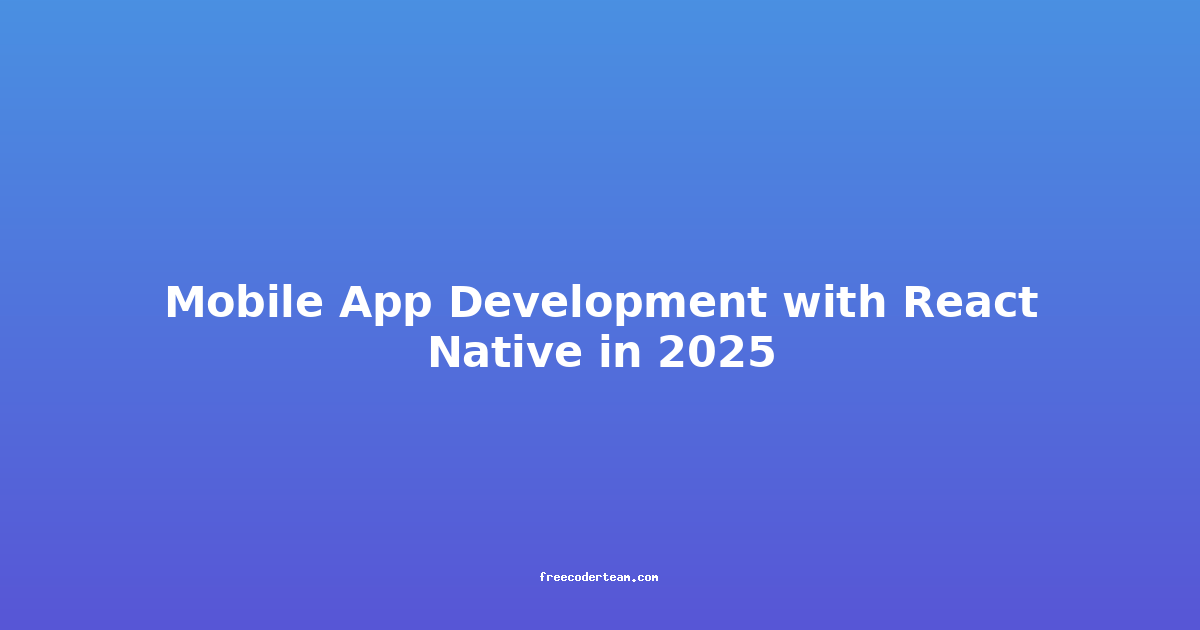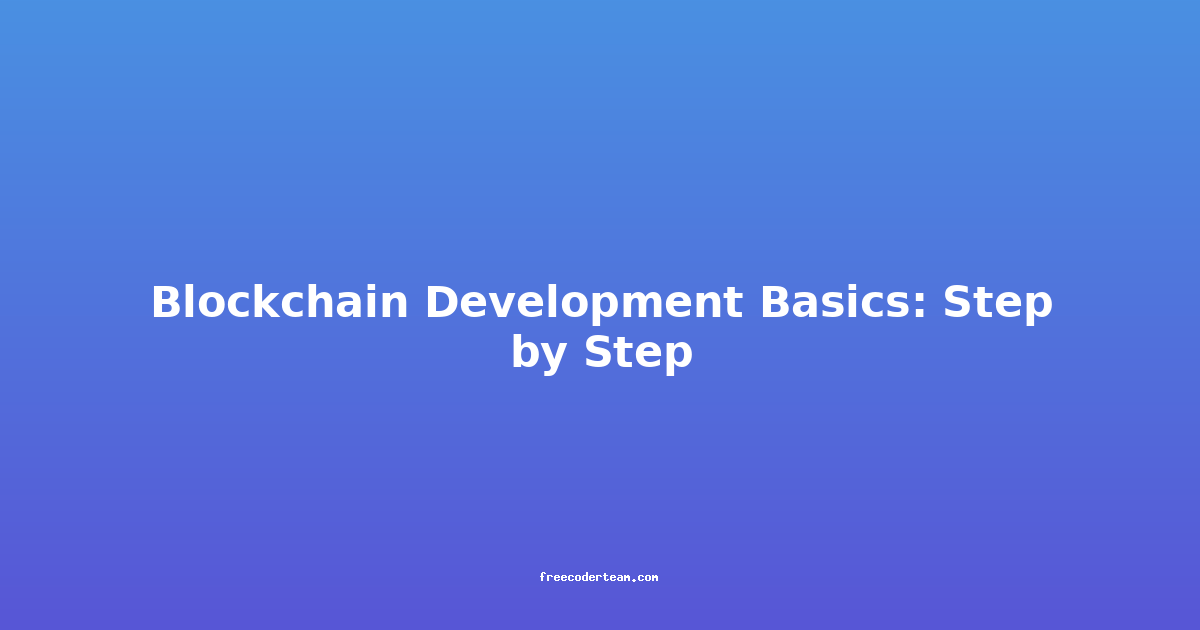Mobile App Development with React Native in 2025: A Comprehensive Guide
As we approach 2025, mobile app development continues to evolve at a rapid pace, driven by advancements in technology, user expectations, and the need for seamless cross-platform experiences. React Native, a popular framework for building mobile apps, has been a staple in the developer community for years. In this blog post, we will explore how React Native is poised to remain a leading choice for mobile app development in 2025, covering its strengths, best practices, practical examples, and actionable insights.
Table of Contents
- Introduction to React Native
- Why React Native in 2025?
- Key Features and Advancements
- Best Practices for React Native Development
- Practical Example: Building a Weather App
- Actionable Insights for 2025
- Conclusion
Introduction to React Native
React Native is a JavaScript framework developed by Facebook that allows developers to build native mobile applications for both iOS and Android platforms using a single codebase. It leverages the power of React, a popular JavaScript library for building user interfaces, and combines it with native components to deliver high-performance apps.
One of the key advantages of React Native is its ability to provide a "write once, run anywhere" approach, reducing development time and costs. Additionally, it offers a rich ecosystem of third-party libraries and tools, making it easier to build complex applications.
Why React Native in 2025?
As we look ahead to 2025, React Native continues to be a strong contender for mobile app development due to several factors:
1. Cross-Platform Development
- Single Codebase: React Native allows developers to write code once and deploy it on both iOS and Android, reducing development time and maintenance costs.
- Native Performance: Unlike web-based frameworks, React Native uses native components, ensuring smooth performance and a seamless user experience.
2. Large and Active Community
- React Native has a thriving community of developers, which means abundant resources, tutorials, and libraries. This community-driven ecosystem ensures continuous innovation and support.
3. Integration with JavaScript Ecosystem
- React Native is built on JavaScript, which is one of the most widely used programming languages. This makes it easier for developers to leverage existing skills and tools, such as Node.js, npm, and popular libraries like Redux and MobX.
4. Adoption by Leading Companies
- Many major companies, including Facebook, Instagram, and Uber, have successfully used React Native for their mobile apps. This adoption by industry leaders underscores its reliability and scalability.
Key Features and Advancements
React Native has evolved significantly over the years, and several features and advancements make it a compelling choice for 2025:
1. Expo and EAS (Expo Application Services)
- Expo: A popular toolchain for React Native that simplifies app development by providing pre-built components and services.
- EAS: Expo Application Services streamline the process of building, testing, and deploying apps, making it easier for developers to focus on building features rather than managing infrastructure.
2. React Native CLI Improvements
- The React Native CLI has been enhanced to provide better support for project initialization, dependency management, and debugging. This makes it easier for developers to set up and maintain projects.
3. Improved Native Modules
- React Native continues to improve its native module system, allowing developers to access platform-specific features more seamlessly. This ensures that apps can leverage the full capabilities of iOS and Android.
4. Dark Mode and Accessibility
- As user expectations for accessibility and design consistency grow, React Native provides robust support for dark mode and accessibility features, ensuring that apps are inclusive and user-friendly.
Best Practices for React Native Development
To build high-quality React Native apps in 2025, developers should follow these best practices:
1. Use Expo for Quick Prototyping
- Why: Expo provides a fast way to get started with React Native, offering pre-built components and services that save time.
- How: Use Expo for initial development and testing. For production, you can eject to a standalone React Native project if needed.
2. Leverage Native Components
- Why: Using native components ensures that your app performs as well as a fully native app.
- How: Use libraries like
react-native-vector-iconsfor icons andreact-native-linear-gradientfor gradients to enhance the native feel.
3. Optimize for Performance
- Why: Performance is critical for user satisfaction. Slow apps can lead to high abandonment rates.
- How:
- Use
FlatListorSectionListfor large datasets to improve scrolling performance. - Implement lazy loading for images and other resources.
- Use tools like
React Native DebuggerandReact Native Performance Monitorto identify bottlenecks.
- Use
4. Focus on Accessibility
- Why: Accessibility ensures that your app is usable by everyone, including users with disabilities.
- How:
- Use
accessibilityLabelandaccessibilityRoleprops to make components accessible. - Test your app with tools like VoiceOver (iOS) and TalkBack (Android).
- Use
5. Adopt a Modular Architecture
- Why: A modular architecture makes your codebase easier to maintain and scale.
- How: Use patterns like Clean Architecture or Domain-Driven Design (DDD) to organize your code. Tools like
react-native-navigationcan help manage navigation effectively.
Practical Example: Building a Weather App
Let's walk through a practical example of building a simple weather app using React Native. This example will demonstrate how to fetch weather data and display it in a user-friendly interface.
Step 1: Set Up the Project
First, initialize a new React Native project using Expo:
npx create-expo-app WeatherApp
cd WeatherApp
Step 2: Install Dependencies
Install the necessary dependencies:
expo install react-native-vector-icons
Step 3: Create the App Structure
Create the following files in your project:
App.js: The main entry point of the app.components/WeatherCard.js: A reusable component to display weather data.services/WeatherService.js: A service to fetch weather data.
Step 4: Implement the Code
App.js
import React, { useState, useEffect } from 'react';
import { View, Text, StyleSheet, TextInput, Button } from 'react-native';
import WeatherCard from './components/WeatherCard';
import WeatherService from './services/WeatherService';
const App = () => {
const [city, setCity] = useState('');
const [weatherData, setWeatherData] = useState(null);
const fetchWeather = async () => {
try {
const data = await WeatherService.getWeather(city);
setWeatherData(data);
} catch (error) {
console.error('Error fetching weather:', error);
}
};
return (
<View style={styles.container}>
<Text style={styles.title}>Weather App</Text>
<TextInput
style={styles.input}
placeholder="Enter city name"
value={city}
onChangeText={setCity}
/>
<Button title="Get Weather" onPress={fetchWeather} />
{weatherData && <WeatherCard data={weatherData} />}
</View>
);
};
const styles = StyleSheet.create({
container: {
flex: 1,
justifyContent: 'center',
alignItems: 'center',
padding: 20,
},
title: {
fontSize: 24,
fontWeight: 'bold',
marginBottom: 20,
},
input: {
width: '80%',
height: 40,
borderColor: 'gray',
borderWidth: 1,
paddingHorizontal: 10,
marginBottom: 10,
},
});
export default App;
components/WeatherCard.js
import React from 'react';
import { View, Text, StyleSheet } from 'react-native';
const WeatherCard = ({ data }) => {
return (
<View style={styles.card}>
<Text style={styles.city}>{data.name}</Text>
<Text style={styles.temp}>{data.main.temp}°C</Text>
<Text style={styles.description}>{data.weather[0].description}</Text>
</View>
);
};
const styles = StyleSheet.create({
card: {
backgroundColor: '#f0f0f0',
padding: 20,
borderRadius: 10,
marginTop: 20,
},
city: {
fontSize: 20,
fontWeight: 'bold',
},
temp: {
fontSize: 32,
fontWeight: 'bold',
},
description: {
fontSize: 16,
color: '#666',
},
});
export default WeatherCard;
services/WeatherService.js
const WeatherService = {
async getWeather(city) {
const apiKey = 'YOUR_API_KEY'; // Replace with your OpenWeatherMap API key
const response = await fetch(
`https://api.openweathermap.org/data/2.5/weather?q=${city}&appid=${apiKey}&units=metric`
);
const data = await response.json();
return data;
},
};
export default WeatherService;
Step 5: Run the App
Start the app using Expo:
expo start
This will launch the app in the Expo Go app on your mobile device or in a simulator.
Actionable Insights for 2025
As you plan your React Native projects for 2025, consider the following actionable insights:
1. Embrace AI and Machine Learning
- Why: AI and ML are becoming integral to mobile apps, offering features like personalized recommendations, image recognition, and natural language processing.
- How: Use libraries like TensorFlow.js or integrate with cloud services like AWS SageMaker or Google Cloud AI to add AI capabilities to your apps.
2. Focus on Security
- Why: As apps handle more sensitive data, security becomes a top priority.
- How: Use secure authentication methods like OAuth 2.0, implement HTTPS for all network requests, and use tools like Firebase for secure data storage.
3. Adopt Progressive Web Apps (PWAs)
- Why: PWAs offer the best of both web and native apps, providing a fast and seamless experience.
- How: Use tools like
react-native-webto build apps that can run as PWAs.
4. Leverage AR and VR
- Why: Augmented Reality (AR) and Virtual Reality (VR) are gaining traction, offering new ways to engage users.
- How: Use libraries like
react-native-arkitfor AR orreact-vrfor VR experiences.
5. Optimize for Performance
- Why: Performance is critical for user retention and satisfaction.
- How: Use tools like
react-native-performanceandreact-native-debuggerto identify and fix performance bottlenecks.
Conclusion
React Native remains a powerful and versatile framework for building mobile apps in 2025. Its ability to deliver native performance with cross-platform capabilities, combined with a thriving community and robust ecosystem, makes it an excellent choice for developers. By following best practices, leveraging new features, and staying ahead of industry trends, you can build high-quality, scalable, and user-friendly apps that meet the demands of the future.
Whether you're a seasoned developer or just starting with React Native, the framework offers endless possibilities for creating innovative and impactful mobile applications. Embrace the power of React Native, and you'll be well-positioned to succeed in the dynamic world of mobile app development.
Happy Coding! 🚀📱




